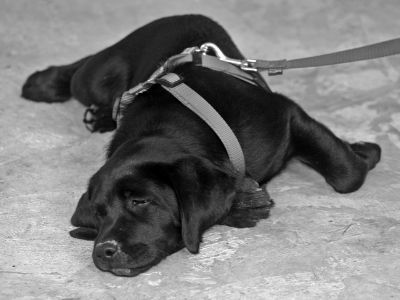Dog Training: Introducing The Lead
Posted on

Whether you live on a housing estate in a built-up area and need your new puppy to learn to walk on the lead from the start, or you live in the countryside with immediate access to open fields, almost all of us will need to put a lead on our dogs at some stage. They aren’t usually best pleased at the idea, but it doesn’t have to be a battle of wills…
I came up with the idea of writing this blog as I was introducing my nine-month-old Labrador, Diego, to the lead for the first time – I’m lucky enough to live on a farm so we have no immediate need for leads. I spent five minutes, if that, with him on a small area of grass and decided that I’d video him the next day to do a little training video to post on my Facebook page to show how much improvement you can achieve in such a short space of time. Well, the video wasn’t as good as I’d hoped because when I put the lead on him the next day, he’d already gone from spiralling round like a lunatic to being calm and accepting. That simply illustrates how quick and easy this can be to master…

Whether your dog is nine weeks or nine months old, they are generally going to react in one of two ways when you put that lead on for the first time (unless you have a wonderful, laidback dog that couldn’t care less):
- They’ll lie down and refuse to move a millimetre, or
- They’ll thrash about, jumping and biting the lead like a crazy thing.
For both options, the key is to ignore the negative behaviour.
If they are choosing to lie down, a lot depends on how stubborn they are. If they can be gently encouraged forwards then reward them with lots of praise for every step they take. If they are adamant that they won’t be moved, you could try a high value treat to tempt them along. Otherwise, simply sit with them until they relax and start to come to you for a fuss. Depending on the temperament of your dog and whether they are a rescue that has been previously mistreated, you may need to do this frequently before your dog is happy to have the lead put on. Short sessions without any pressure are key. This can be done in the house; try putting the lead on whilst you’re sat in the lounge, lots of relaxed fussing and then encourage your dog to walk with you, on the lead, to the kitchen for their meal time – removing the lead to allow them to eat in peace. Slowly build from there.

If they are the ‘turn into a fish on the end of a line’ type, then patience is just as important. Simply stand and wait – ensuring that they can’t injure themselves. When they are calm, even if it’s just for a few seconds in between surges of thrashing about, be sure to praise calmly. As soon as they start to jump about again, fall silent. It really is as simple as that; it’s a very easy yet effective method that teaches your dog which is the most beneficial behaviour to him/her.
Once you and your dog are comfortable with the lead, it's time to move on to walking nicely to heel. Luckily enough, I've written an article on that too! Check it out here.
Related Articles:
Puppy Training: Recall
Puppy Training: Sit
Puppy Training: Why 'Sit And Stay' Isn't A Thing
Dog Training: Lead Walking

Add a comment: